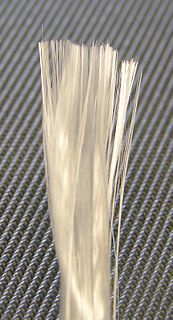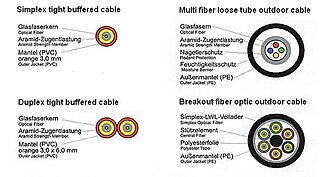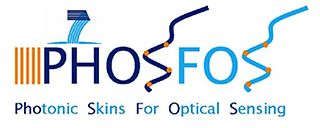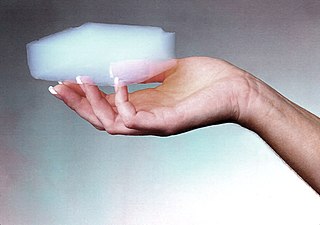
A gel is a solid jelly-like soft material that can have properties ranging from soft and weak to hard and tough. Gels are defined as a substantially dilute cross-linked system, which exhibits no flow when in the steady-state. By weight, gels are mostly liquid, yet they behave like solids due to a three-dimensional cross-linked network within the liquid. It is the crosslinking within the fluid that gives a gel its structure (hardness) and contributes to the adhesive stick (tack). In this way gels are a dispersion of molecules of a liquid within a solid in which liquid particles are dispersed in the solid medium. The word gel was coined by 19th-century Scottish chemist Thomas Graham by clipping from gelatine.
In telecommunications and fiber optics, a plastic-clad silica fiber or polymer-clad silica fiber (PCS) is an optical fiber that has a silica-based core and a plastic cladding. The cladding of a PCS fiber should not be confused with the polymer overcoat of a conventional all-silica fiber. PCS fibers in general have significantly lower performance characteristics, particularly higher transmission losses and lower bandwidths, than all-glass fibers.
For an optical fiber, a step-index profile is a refractive index profile characterized by a uniform refractive index within the core and a sharp decrease in refractive index at the core-cladding interface so that the cladding is of a lower refractive index. The step-index profile corresponds to a power-law index profile with the profile parameter approaching infinity. The step-index profile is used in most single-mode fibers and some multimode fibers.
In a single-mode optical fiber, the zero-dispersion wavelength is the wavelength or wavelengths at which material dispersion and waveguide dispersion cancel one another. In all silica-based optical fibers, minimum material dispersion occurs naturally at a wavelength of approximately 1300 nm. Single-mode fibers may be made of silica-based glasses containing dopants that shift the material-dispersion wavelength, and thus, the zero-dispersion wavelength, toward the minimum-loss window at approximately 1550 nm. The engineering tradeoff is a slight increase in the minimum attenuation coefficient. Such fiber is called dispersion-shifted fiber.

Fiber or fibre is a natural or synthetic substance that is significantly longer than it is wide. Fibers are often used in the manufacture of other materials. The strongest engineering materials often incorporate fibers, for example carbon fiber and ultra-high-molecular-weight polyethylene.

Glass fiber is a material consisting of numerous extremely fine fibers of glass.
All-silica fiber, or silica-silica fiber, is an optical fiber whose core and cladding are made of silica glass. The refractive index of the core glass is higher than that of the cladding. These fibers are typically step-index fibers. The cladding of an all-silica fiber should not be confused with the polymer overcoat of the fiber.

Photonic-crystal fiber (PCF) is a class of optical fiber based on the properties of photonic crystals. It was first explored in 1996 at University of Bath, UK. Because of its ability to confine light in hollow cores or with confinement characteristics not possible in conventional optical fiber, PCF is now finding applications in fiber-optic communications, fiber lasers, nonlinear devices, high-power transmission, highly sensitive gas sensors, and other areas. More specific categories of PCF include photonic-bandgap fiber, holey fiber, hole-assisted fiber, and Bragg fiber. Photonic crystal fibers may be considered a subgroup of a more general class of microstructured optical fibers, where light is guided by structural modifications, and not only by refractive index differences.

Fiber cement siding is a building material used to cover the exterior of a building in both commercial and domestic applications. Fiber cement is a composite material made of cement reinforced with cellulose fibers. Originally, asbestos was used as the reinforcing material but, due to safety concerns, that was replaced by cellulose in the 1980s. Fiber cement board may come pre-painted or pre-stained or can be done so after its installation.
Plastic optical fiber (POF) is an optical fiber that is made out of polymer. Similar to glass optical fiber, POF transmits light through the core of the fiber. Its chief advantage over the glass product, other aspect being equal, is its robustness under bending and stretching. Optical fiber used in telecommunications is governed by European Standards EN 60793-2-40-2011.

Filler materials are particles added to resin or binders that can improve specific properties, make the product cheaper or a mixture of both. The two largest segments for filler material use is elastomers and plastics. Worldwide, more than 53 million tons of fillers are used every year in different application areas, such as paper, plastics, rubber, paints, coatings, adhesives and sealants. As such, fillers, produced by more than 700 companies, rank among the world's major raw materials and are contained in a variety of goods for daily consumer needs. The top filler materials used are ground calcium carbonate (GCC), precipitated calcium carbonate (PCC), kaolin, talc, and carbon black. Filler materials can affect the tensile strength, toughness, heat resistance, color, clarity etc. A good example of this is the addition of talc to polypropylene. Most of the filler materials used in plastics are mineral or glass based filler materials. There are two main subgroups of filler materials: particulates and fibers. Particulates are small particles of filler which are mixed in the matrix where size and aspect ratio are important. Fibers are small circular strands that can be very long and have very high aspect ratios.
Polymer nanocomposites (PNC) consist of a polymer or copolymer having nanoparticles or nanofillers dispersed in the polymer matrix. These may be of different shape, but at least one dimension must be in the range of 1–50 nm. These PNC's belong to the category of multi-phase systems that consume nearly 95% of plastics production. These systems require controlled mixing/compounding, stabilization of the achieved dispersion, orientation of the dispersed phase, and the compounding strategies for all MPS, including PNC, are similar. Alternatively, polymer can be infiltrated into 1D, 2D, 3D preform creating high content polymer nanocomposites.

In textile manufacturing, finishing refers to the processes that convert the woven or knitted cloth into a usable material and more specifically to any process performed after dyeing the yarn or fabric to improve the look, performance, or "hand" (feel) of the finish textile or clothing. The precise meaning depends on context.
Colloidal silicas are suspensions of fine amorphous, nonporous, and typically spherical silica particles in a liquid phase.
Hydrophobic silica is a form of silicon dioxide that has hydrophobic groups chemically bonded to the surface. The hydrophobic groups are normally alkyl or polydimethylsiloxane chains. Hydrophobic silica can be processed in different ways; such as fumed silica, precipitated silica, and aerosol assisted self assembly, all existing in the form of nanoparticles.

Hard-clad silica (HCS) or polymer-clad fiber (PCF) is an optical fiber with a core of silica glass and an optical cladding made of special plastic. In contrast to all-silica fiber, the core and cladding can be separated from each other.

PhoSFOS is a research and technology development project co-funded by the European Commission.
Cladding in optical fibers is one or more layers of materials of lower refractive index, in intimate contact with a core material of higher refractive index. The cladding causes light to be confined to the core of the fiber by total internal reflection at the boundary between the two. Light propagation in the cladding is suppressed in typical fiber. Improving transmission through fibers by applying a cladding was discovered in 1953 by Dutch scientist Bram van Heel. Some fibers can support cladding modes in which light propagates in the cladding as well as the core.

Aerogel is a synthetic porous ultralight material derived from a gel, in which the liquid component for the gel has been replaced with a gas. The result is a solid with extremely low density and low thermal conductivity. Nicknames include frozen smoke, solid smoke, solid air, solid cloud, blue smoke owing to its translucent nature and the way light scatters in the material. It feels like fragile expanded polystyrene to the touch. Aerogels can be made from a variety of chemical compounds.













